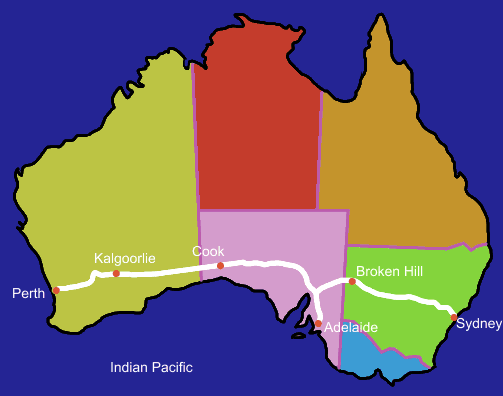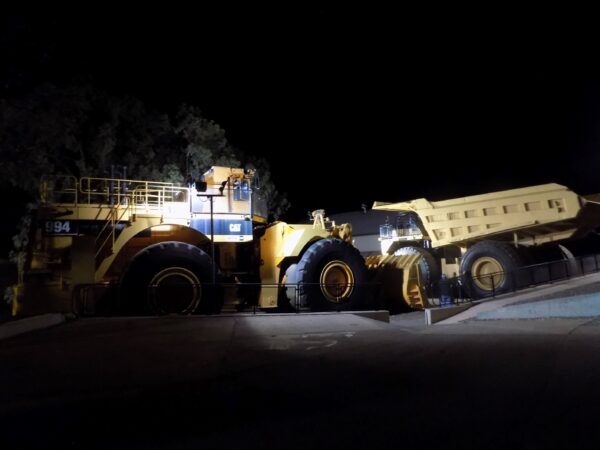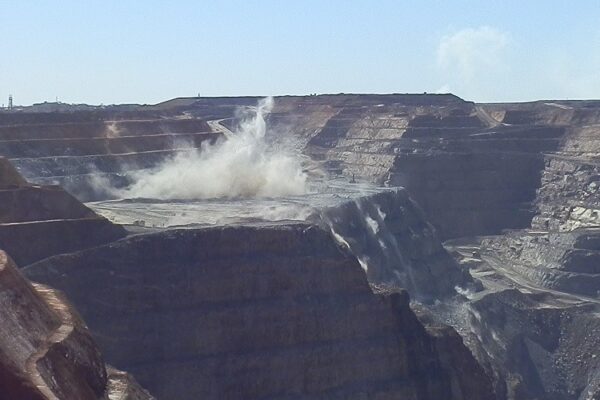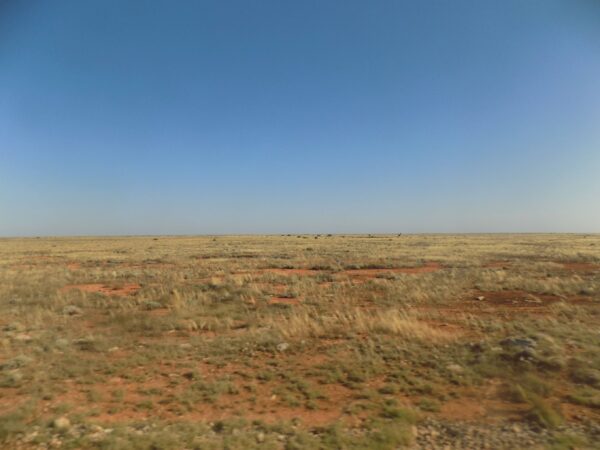Ride the train from Sydney to Melbourne and while you’ll have stops along the way at places named Broadmeadows, Seymour, and Campbelltown, you’ll also stop at Benalla, Wangaratta, Wagga Wagga, Junee, and Cootamundra. The frequency of stops and this mixture of place names reflects the density of population whether Indigenous or European along Australia’s east coast.
Sunday morning 3 November, our group would board a different train – the Indian-Pacific (IP) for a two day ride along half this famous train’s route. Tuesday morning we’ll disembark at Adelaide while the train will continue to Sydney completing its run from the Indian Ocean to the Pacific. (Hence the name Indian-Pacific.) Along the way we’d cross the Nullarbor and make just two stops at Kalgoorlie and Cook.
It’s easy to think that the exotic sounding Nullarbor is another indigenous term. It isn’t. Here’s the first paragraph (without links) from its Wikipedia page:
The Nullarbor Plain (/ˈnʌlərbɔːr/ NUL-ər-bor; Latin: nulla feminine of nullus ‘no’ and arbor ‘tree’) is part of the area of flat, almost treeless, arid or semi-arid country of southern Australia, located on the Great Australian Bight coast with the Great Victoria Desert to its north. It is the world’s largest single exposure of limestone bedrock, and occupies an area of about 200,000 square kilometres (77,000 sq mi). At its widest point, it stretches about 1,100 kilometres (684 mi) from east to west across the border between South Australia and Western Australia.
Yes, Nullarbor is from Latin.
When we reach the Nullarbor, we’ll encounter one particularly notable feature of the IP. The tracks run straight for 478 kilometers making it the longest straight stretch of railway track on Earth. Now, if you’re the driver – or even sitting with the driver – I’m sure you’d notice but it’s not something you notice as a passenger. Here’s the train’s route with that straight stretch between Kalgoorlie and Cook.

[From Wikipedia By No machine-readable author provided. 17177 assumed (based on copyright claims) CC BY-SA 3.0]
On this train journey I will pass through places cared for by many family and language groups who are traditional caretakers and custodians of Country. I would like to acknowledge all the Traditional Custodians of this land and pay respect to all the Elders past, present, and emerging.
All Aboard
Most individual guests will board the train at the East Perth Terminal, check their luggage, and be escorted to a waiting area where they’re served cakes and beverages prior to the IP’s mid-morning departure. Since we boarded as a group, our experience was a bit different. We were shuttled from our hotel to the Perth Convention Centre where we checked our luggage, were served light refreshments, and were entertained by a live musician until we were shuttled to the East Perth Terminal.
Observant readers might notice that I italicized the statement “we checked our luggage”. Packing for a multi-night (in this instance two nights) train trip requires different planning than one uses for air travel. As it is on a plane, on a train, your checked luggage is in the baggage car – gone until you reach your destination. The main difference is that your plane will reach its destination in hours. Your train could require days. This means you need to put everything you need for two days in your carry-on. When you’re a solo traveler like me the typical cabin size exacerbates the challenge.

The midnight train from Kalgoorlie
(All your digging for gold.)
Our train left Perth in the morning traveling more or less directly east. In about a dozen hours we’d reach Kalgoorlie where we were offered what the operators called an “Off-train Experience.” The experience in Kalgoorlie is a pit mine. But not just any pit mine. At Kalgoorlie, it’s the Super Pit.
Officially it’s the Fimiston Open Pit and it’s a super pit because it combined several gold mines into a single massive open pit mine. The first discovery of gold near this location was 100 ounces of gold by Paddy Hannan, Tom Flanagan, and Daniel Shea in 1893. Hannan often gets sole credit because he was the one who registered the claim in Coolgardie a town 40 kilometers to the west that was founded a year earlier following the discovery of gold there.
Hannan’s discovery, in an area called Kalgoorlie-Boulder, led to a gold rush and the opening of one of the world’s riches gold deposits – the Golden Mile. Over the next century, the Golden Mile produced more than 40,000,000 ounces of gold. The Super Pit itself covers an area nearly 3 and a half kilometers long, 1 and a half kilometers wide, and is more than 600 meters deep. It operates 24 hours a day seven days a week.
I wasn’t sure what to expect but it was included in the ticket, the train was stopping for three hours or so nearby, and I hoped that at the least I’d get a clear dark night view of the southern sky.
Our first stop was at Hannan’s North Tourist Mine

where we saw some equipment worthy of what was once the largest pit gold mine in Australia. (In 2016 another mine in Western Australia – the Newmont Boddington gold mine surpassed it.) Here we picked up a bit of the mine’s history, the fact that it’s expected to remain operating until 2035, and, of course, the opportunity to make a purchase in the gift shop. As for a good view of the night sky, clouds and light pollution from our proximity to Kalgoorlie rendered that endeavor hopeless.
From there it was on to the mine itself. They usually don’t blast at night and this Sunday was no exception. We stood at the viewing platform looking into a dark pit with equipment akin to that in the above photo so far distant they looked like Tonka trucks. And the view of the sky here was little better. Here’s an idea of what a daytime visitor might see. This is only a section of the pit.

[From the travel website Salt and Charcoal]
We returned by bus to the waiting train arriving sometime near midnight. The train departed and, while we were sleeping enter the Nullarbor Plain. I was in the group scheduled for 07:00 breakfast but was in the club car sipping tea sometime before that. The Nullarbor is vast – more than 1,000 kilometers from west to east. It’s also not particularly interesting but I still had time to take a few photos like this one.

And it generally looked like this for hundreds of kilometers.
Although the club car of the train would prove to be the place where I spent most of my time on board engaged in lively conversation with not only others in the Road Scholar group but with several of the Aussies who were on their own personal train treks, it was also two days and nights on a train with a repetitive landscape. The experience reminded me a bit (but just a bit) of the ride across Siberia in that respect.
For me, coming to understand the relationship Australia’s Indigenous People have with Country was not simply revelatory it was critical and, to some degree life-altering. I’ve been trying to weave my understanding of that relationship into the narrative and will continue to do so. However, because we have two nights on the train plus a day crossing the Nullarbor, I’m going to devote some time to explaining this to the best of my apperception – beginning with the arrival of Australia’s First People at least 60,000 years ago.
The entire process is a bit intimidating not merely because this relationship, while similar to the relationship the Indigenous People of America had with their land, it is unlike it in subtle ways that I’ve found difficult to articulate. Further, assimilating all of it in a short time while simultaneously trying to be present in my other experiences on this trip heightens the challenge but I shall try nevertheless.